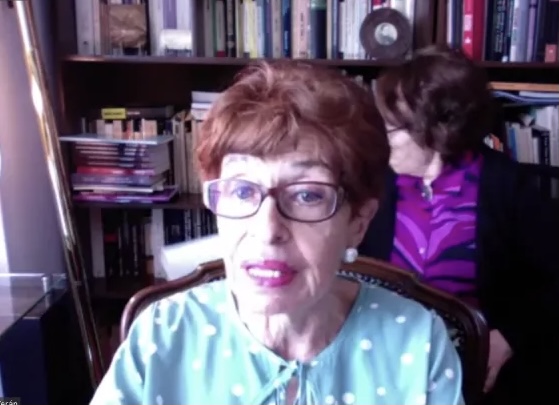Laura Hidalgo Alzamora (Riobamba, November 18, 1937) is an Ecuadorian writer, scholar, literary critic, and professor. She is the author of several books on Ecuadorian literature, such as “La mujer en la literatura ecuatoriana de tradición oral” (1989), “Décimas esmeraldeñas” (1990), and “Un lenguaje desnudo” (1995). From 1989-1990, she was the secretary general of the House of Ecuadorian Culture. Since May 11, 2016, she has been a corresponding member of Ecuador’s Academy of Language. She has lectured on Ecuadorian literature at conferences in Peru, Austria, and the U.S., including Boston, New Mexico and Kentucky. Since 1993, she has been a literature professor at the San Francisco University of Quito (USFQ).
Introduction
Dr. Laura Hidalgo Alzamora is a renowned Ecuadorian author and academic, born on November 18, 1937, in Riobamba, Ecuador. She is known for her significant contributions to the literature and education sector, with a particular focus on Ecuadorian cultural heritage.
Education
Dr. Hidalgo Alzamora commenced her education journey at Colegio María Auxiliadora in Guayaquil. She attended secondary school at Colegio de Fátima in Quito before pursuing her higher studies at Pontifical Catholic University of Ecuador in Quito. In 1978, she graduated with a degree in Education Sciences, specializing in Literature and Spanish, and later earned her doctorate in Literature in 1982.
Career Overview
Dr. Laura Hidalgo Alzamora has had an illustrious career in academia spanning several decades. She has served as a full-time professor of Literature and Socratic Courses at the Universidad San Francisco de Quito since 1993. Prior to this, from 1978 to 1986, she was a Professor of Ecuadorian Literature and Methodology of Scientific Work at the Pontifical Catholic University of Ecuador. She also spent a summer in 1987 teaching Linguistics at the Santiago de Guayaquil Catholic University.
Outside of teaching, she held an administrative role as the Secretary General of the House of Ecuadorian Culture “Benjamín Carrión” from 1989 to 1990. In addition, she utilized her expertise in language and literature as a Professor-Instructor of Castilian Writing at the Business Training Center (CEFE) from 1985 to 2005. Her career also included a stint as a Literature Professor at the Higher Institute “Luis N. Dillon” from 1975 to 1992. This broad range of roles demonstrates Dr. Hidalgo Alzamora’s deep commitment to education and her significant contributions to the cultural and literary heritage of Ecuador.
Contributions to Ecuadorian Literature and Oral Traditions
Dr. Laura Hidalgo Alzamora has made numerous significant contributions to Ecuadorian literature, particularly in the areas of literary analysis and the preservation of traditional oral and folk literature.
Her dedication to preserving Ecuadorian oral and folk traditions is evident in “Décimas esmeraldeñas” and “Coplas del Carnaval de Guaranda.” In these works, she compiled, and conducted socioliterary analyses of, folk poems from the black community of the Esmeraldas Province and popular verses from the Bolívar Province, respectively. In “Mariangula y otros aparecidos,” Dr. Hidalgo Alzamora compiled popular tales, legends, and traditions from six provinces in Ecuador, providing an invaluable resource for those interested in Ecuadorian folklore.
Additionally, she has written numerous essays on the works of prominent Ecuadorian authors such as Demetrio Aguilera Malta, Alfredo Pareja Diezcanseco, Edmundo Ribadeneira, Miguel Donoso Pareja, Abdón Ubidia, Javier Vásconez, Javier Ponce Cevallos, and Julio Pazos. These works have been published in various journals and also serve as introductions to the authors’ respective works. One of her most notable works is “Un Lenguaje Desnudo,” a critical literary analysis of Jorge Enrique Adoum’s novel “Entre Marx y una mujer desnuda,” which was published by the Casa de la Cultura Ecuatoriana (House of Ecuadorian Culture) in 1995.
Her varied and extensive body of work reflects a deep commitment to Ecuadorian literature and culture, and her scholarly contributions offer critical insights into the country’s rich literary traditions.
Member of
- Ecuadorian Society of Writers (SEDE).
- House of Ecuadorian Culture “Benjamín Carrión.”Literature Section.
- Group “America.”
- “Quito Literary Workshop.”
- Corresponding Member of the Ecuadorian Academy of Language.
Videos
Laura Hidalgo Alzamora discusses oral tradition
Works
- Tesis de Licenciatura: “Entre Marx y una mujer desnuda o la novela Otra”. Quito, cultura 1, Banco Central del Ecuador, 1987 (220 pp.)
- Tesis Doctoral: “Décimas Esmeraldeñas”. Quito, Banco Central del Ecuador, 1983 (474 pp.)
- Coplas del Carnaval de Guaranda, Quito, Editorial el Consejo, 1984 (301 pp.)
- El Método Lógico-Histórico para la periodización de la Literatura Ecuatoriana, Quito Cultural 9, Banco Central del Ecuador, 1982.
- Del Ritmo al concepto en la poesía de Antonio Preciado, Quito, Cultural 7, Banco Central del Ecuador, 1980.
- Análisis Literario sobre la narrativa de: Demetrio Aguilera Malta, Edmundo Rivadeneira, Miguel Donoso Pareja, Abdón Ubidia, Javier Vásconez, Alfredo Pareja Diezcanseco; sobre la poesía de Julio Passos Barrera.
- La mujer en la literatura ecuatoriana de tradición oral.
- Mariangula y otros aparecidos: Literatura oral ecuatoriana (2000)
- Décimas esmeraldeñas: Recopilación y análisis socio-literario (1990). Read it here.
- Un lenguaje desnudo (1995)
- Duendes y Duendas – más otros aparecidos de aquicito nomás (2013)
- “Aplicación de la Morfología de Propp al análisis de un Cuento Folklórico Ecuatoriano,” Folklore Americano 48. México (julio–diciembre 1989): pp. 875-892.
- ¨Amorfinos de la Provincia del Guayas¨ AMERICA 118, (Septiembre de 1996): pp. 213-234.
Author name variations
- Laura Hidalgo Alzamora
- Laura Hidalgo
- Laura Hidalgo A.

